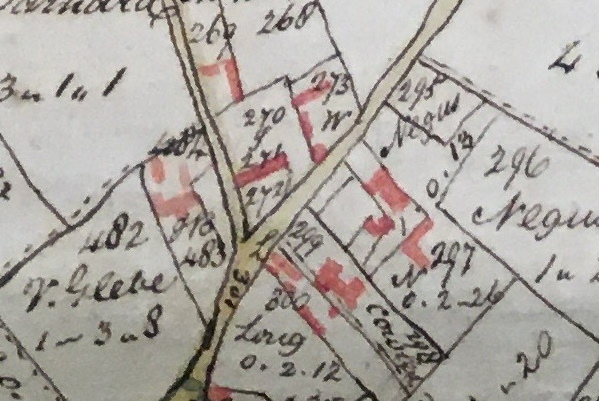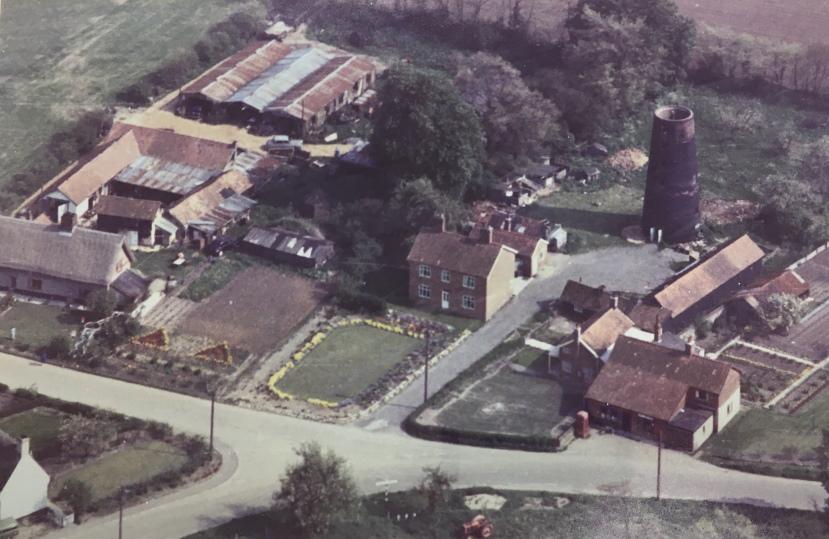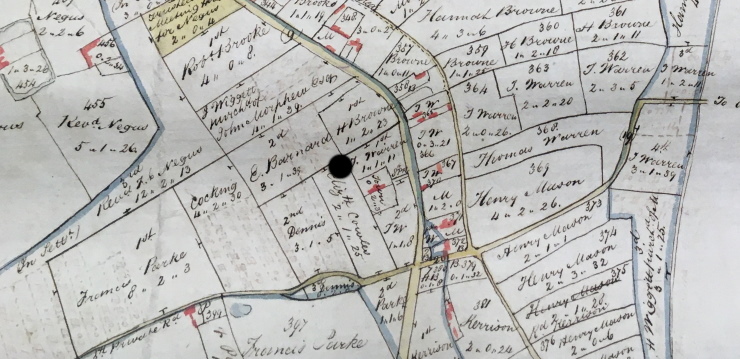1818 Auction of Freehold Property
On the 28th February, 1818, the Norfolk Chronicle published the notice of a forthcoming auction of premises in Great Ellingham.
The auction would take place at four o’clock on the 12th March, 1818, at the Crown Public House in Great Ellingham. The premises appeared in two lots:
- Lot 1 – The reversion or remainder in fee [simple] expectant on the decease of a Widow aged 67, of and in all that Messuage, situate in Great Ellingham aforesaid, with an old-established Baking-Office, Double Cottage, Barn, Stable, and other Out-buildings, and a Hempland adjoining, containing altogether, two roods and 32 perches, now in the respective occupations of Benjamin Buck, Elizabeth Cowles, and others.
- Lot 2 – Also of and in all that piece of excellent Arable land, late parcel of the Common Pasture of Great Ellingham aforesaid, containing two acres and two roods.
This throws up several questions. Whereabouts was the property and land in Great Ellingham? Who was the ‘Widow aged 67″? What does the ‘reversion or remainder in fee simple expectant’ mean?
1824 Deed of Assignment
Extract from 1824 unsigned Assignment of Lease between John Taylor, Henry Norton & Edward Palmer Clarke. Courtesy of Wymondham Town Archive
An unsigned Deed of Assignment of 1824 provides some clarity. The majority of property deeds from this period recite extracts from earlier deeds and, in doing so, provide background information about the transaction and the people involved. This unsigned Deed is no exception.
The Assignment Deed describes the same property and land in Great Ellingham mentioned in Lots 1 and 2 of the 1818 notice of auction.
Where was the Property & Land?
Lot 1 – Messuage with Baking Office and Double Cottage
The 1824 Deed refers to the premises comprised in Lot 1 (of the 1818 Auction Notice) as:
- “First all that messuage or tenement together with the Baking Office, Barn, Stables, outbuildings, yards and gardens thereto belonging and held therewith and also all that double cottage tenement with the outbuildings, yards and gardens thereto belonging and held therewith and also all that piece or parcel of land and ground situate and adjoining to the said messuage, cottages and premises ….”
The Deed also tell us that the land and property amounted to two roods and 32 perches. It also tells us the names of the owners of the adjoining properties.
The Executors of Samuel Pygall owned the land to the east, a widow with the name of Howes owned the premises to the west, to the south were lands belonging to John Towler and to the north the King’s Highway.
The premises were also said to be formerly occupied by Mary Howard (and her undertenants), but now occupied by Benjamin Buck, Elizabeth Cowles, a person with the name Levell (Lebbell) and Jane Carter.
1802 Map
Extract from 1802 Map of Great Ellingham. Original held at Norfolk Record Office. Russell James Colman Plans. Cat. Ref. C/Ca 1/84.
With kind permission of NRO
This property and land (Lot 1) is identified by the numbers 298, 299 and 300 on the above extract of an 1802 map of Great Ellingham.
1800 Particulars & Valuation
The numbering used on the map concurs with the numbering used in a Particulars & Valuation of Great Ellingham dated 1800. It shows:
- No.300 Cottage Barn & Yard comprising 15 perches owned and occupied by Elizabeth Cowles
- No.299 House, Baking Office, Yard & Garden comprising 32 perches owned by Elizabeth Cowles and occupied by Henry Neale (later occupied by Benjamin Buck)
- No. 298 Piece behind Baking Office comprising two roods owned by Elizabeth Cowles and which was also occupied by Henry Neale (later by Benjamin Buck)
Although there is a discrepancy of 15 perches between the description of the premises in Lot 1 of the 1818 auction notice, and the description of the premises owned by Elizabeth Cowles set out in the Particulars and Valuation of 1800, I am confident that this is the same premises.
The premises is in what we today know as Church Street. The adjacent parcels of land numbered 295 and 297 on the extract of the 1802 map, is the adjacent property referred to in the 1824 Deed as then belonging to the Executors of Samuel Pygall. In 1800, this property was in the ownership of the Reverend F C Negus. Today, this property is known as Mill Farmhouse.
Later Building on the Site
Photograph taken 1965 showing the Mill House with outbuildings in the centre together with the brick tower. Mill Farmhouse to the left and the Post Office to the right. Courtesy of Angela Crocker
Around 1849, Jeremiah Fielding built a brick tower windmill on this site. The tower remains today. The present Mill House was built in 1904 to replace an earlier house, which was partly destroyed by fire. This earlier house may well have been the messuage once owned by Elizabeth Cowles. A nearby cottage may also have been part of the premises once in the ownership of Elizabeth Cowles.
Lot 2 – Arable Land late parcel of the Common Pasture
The 1824 Deed also refers to the land comprised in Lot 2 of the auction notice of 1818 as:
- “Secondly all that piece or parcel of land late parcel of the common pasture of Great Ellingham aforesaid.. “
The piece of land, which measured two acres and two roods, was bounded by the Town Lands of Great Ellingham to the east, by lands then (or formerly) of Porter Dennis to the west, by lands of John Taylor to the north and by a private road to the south.
1802 Map
This additional information allows us to pinpoint the parcel of land on the 1802 map of Great Ellingham. It lies to the west of Long Street.
Extract from 1802 Map of Great Ellingham. Original held at Norfolk Record Office. Russell James Colman Plans. Cat. Ref. C/Ca 1/84. With kind permission of NRO
1800 Particulars & Valuation
The Particulars & Valuation of Great Ellingham dated 1800 reveals that Elizabeth Cowles also owned and occupied an allotment on Town Green measuring two acres, one rood and 25 perches.
The black dot on the above extract from the 1802 map shows the position of the parcel of land. It is bounded by the the ‘Town House‘ (the Town Lands of Great Ellingham) to the east, by lands of ‘Dennis‘ to the west, by lands of ‘E Barnard‘ to the north (later owned by John Taylor), and by a private road (Shruggs Lane) to the south.
Although there is a small discrepancy between the measurement of the parcel of land given in the Particulars & Valuation and the measurement of two acres and two roods in the description of Lot 2 in the auction notice of 1818, I am confident it is the same piece of land.
The Reversion or Remainder in Fee Expectant on the decease of a Widow aged 67
The 1824 unsigned Deed tells us that ‘the Widow aged 67’ is Elizabeth Cowles.
Richard & Elizabeth Cowles
Richard Cowles married Elizabeth Cooper in the Parish Church of Great Ellingham on the 10th July, 1792. Richard was a widower and Elizabeth a spinster. They both lived in the village.
On the 29th July, 1776, Richard married his first wife, Susanna Burgamy, in St Mary’s Church, Attleborough. There were at least two children from the union: Richard, baptised in St Mary’s Church on the 6th March, 1777, and Robert, baptised on the 4th February, 1779. Susanna Cowles died in April 1784.
8 years later, Richard and Elizabeth Cowles married. I do not believe Richard had any children with his second wife Elizabeth.
1796 Mortgage
Four years after the marriage, Richard Cowles mortgaged all his property in Great Ellingham. An extract of a Deed of Mortgage dated 18th November, 1796, is set out in the unsigned 1824 Deed of Assignment.
Richard Cowles borrowed the sum of £50 (with interest) from John Taylor, a gentleman, of Thuxton, Norfolk, on a term of 1000 years. However, the term would be void on payment of the £50 plus the interest on the 18th May the following (i.e. 18th May, 1797).
Death of Richard Cowles
As it happened, Richard Cowles died just weeks before the debt was due to be repaid. His last will and testament dated 9th June, 1795 was proved on the 2nd May, 1797, some sixteen days before the debt was due. Nevertheless, with the mortgage outstanding, widow Elizabeth Cowles remained in occupation of all her late husband’s property and land.
1818 Sale to Henry Norton
The auction in 1818 of the two Lots, relate to the subsequent sale by Richard Cowles’ son, Richard, to Henry Norton of Old Buckenham.
The 1824 unsigned Deed recites extracts from Deeds of Lease and Release dated the 9th and 10th July, 1818. These two documents relate to the sale to Henry Norton. Ellis Palmer was also a party to both the Lease and Release. However, the extracts of these two Deeds are silent as to the nature of Ellis Palmer’s involvement in the transaction.
Richard Cowles (the son) was a yeoman of Attleborough. The Deeds describe this Richard Cowles as the only brother and heir of Robert Cowles. Robert Cowles was also a yeoman of Attleborough. However, he died before 1818. Notwithstanding that Robert Cowles was younger than this brother Richard, it seems likely that Robert Cowles was the beneficiary of his late father Richard Cowles’ will. However, Robert died intestate without children, and his estate passed to his elder brother, Richard.
Henry Norton paid £150 for all the property and land once owned by Richard Cowles (senior) i.e. all the land and property described in Lots 1 and 2 in the auction notice of February, 1818.
Life Tenancy of Elizabeth Cowles
Nevertheless, the sale to Henry Norton was subject to the life tenancy of Elizabeth Cowles. I have no doubt that in his will of 1795, Richard Cowles (senior) provided for his wife Elizabeth to occupy all his property and land until her death (or, until she remarried).
Therefore, Richard Cowles (the son), could only sell ‘the reversion or remainder in fee simple expectant on the decease of a Widow aged 67′ in the property. The sale was also subject to the existing mortgage in favour of John Taylor. Accordingly, Henry Norton took on the mortgage debt to John Taylor.
Death of Elizabeth Cowles
Elizabeth Cowles’ life interest in all her late husband’s property came to an end when she died at the age of 73 in December, 1823. The registers for the Baptist Church in Great Ellingham record the burial of Elizabeth Cowles on the 10th December, 1823.
Proposed Redemption of the 1796 Mortgage
The death of Elizabeth Cowles meant that Henry Norton’s property and land (which was previously owned by Richard Cowles), was finally free from the life tenancy. However, the premises remained mortgaged to John Taylor.
The year after Elizabeth Cowles’ death, Henry Norton repaid (or intended to repay) the outstanding loan to John Taylor.
When a mortgage was repaid in full, the 1000 year lease (or whatever the term of the mortgage) would need to be formally terminated. The 1824 Deed of Assignment was drafted to deal with this.
Extract from 1824 unsigned Assignment of Lease between John Taylor, Henry Norton & Edward Palmer Clarke. Courtesy of Wymondham Town Archive
The Deed also included a receipt by John Taylor acknowledging the repayment in full of the outstanding debt. Spaces were left in the manuscript Deed for the appropriate figures for the principal sum of £50 plus the interest accrued, to be inserted.
However, the Deed is unsigned and the figures for the appropriate sums were not inserted. It is impossible to say whether or not the mortgage was repaid at that time and, the subseqent Assignment Deed, completed.
However, given that more than one draft of the Deed was very likely prepared, perhaps at least one of the copies was signed by the parties i.e. John Taylor (the lender), Henry Norton (the owner) and Edward Palmer Clarke (the appointed trustee of Henry Norton to whom the remainder of the term of the lease was assigned as was then customary to do).
Conclusion
In conclusion, the premises and land described in Lot 1 of the auction notice of 1818, was in Church Street, Great Ellingham, near to the junction with Chequers Lane and Long Street.
The land mentioned in Lot 2 lies to the west of Long Street, and abuts Shrugs Lane.
Widow Elizabeth Cowles occupied all the premises and land under the terms of a life tenancy granted to her by her late husband, Richard Cowles.
Just six months before his death, Richard Cowles mortgaged all the premises and land to John Taylor.
In 1818, Henry Norton purchased both Lots 1 and 2. The purchase was subject to the life tenancy of Elizabeth Cowles and the mortgage debt to John Taylor.
This leaves further questions: Did Henry Norton repay the mortgage to John Taylor in 1824? How long did Henry Norton own the property? Who was the next owner?
Sources:
1802 Russell James Colman Plans. Great Ellingham. Norfolk Record Office. Catalogue Ref. C/Ca 1/84.
1799-1842 F W Horner, Records of the Surveyors to Commissioners for Inclosure in Parishes in Norfolk and Suffolk. Great Ellingham (Act 1799). Norfolk Record Office. Catalogue Ref: NRO, BR 90/2
1800 Inclosure Commissioner’s Particulars and Valuation, Great Ellingham. Norfolk Record Office. Catalogue Ref: NRO, MC 2213/119
1799 Statement of Claims. Great Ellingham Inclosure. Norfolk Record Office. Catalogue Ref: MC 2213/118
Great Ellingham Parish Registers. Norfolk Record Office. PD 609. Also available at https://www.familysearch.org
Attleborough Parish Registers. Norfolk Record Office. PD 438. Transcriptions Norfolk Family History Society. https://www.norfolkfhs.org.uk
1824 Unsigned Assignment of a Lease of a Term of 1000 years. John Taylor to E P Clarke as trustee for Henry Norton. Wymondham Town Archive. ID. 13057. Box 94/12.
Norfolk Chronicle 28 February 1818. Viewed via The British Newspaper Archive. https://www.britishnewspaperarchive.co.uk 30 July 2021.
England & Wales, Non-Conformist and Non-Parochial Registers, 1567-1970
RG4: Registers of Births, Marriages and Deaths Norfolk Baptist Piece 1254: Great Ellingham (Baptist), 1817-1837. The National Archives of the UK; Kew, Surrey, England; General Register Office: Registers of Births, Marriages and Deaths Surrendered to the Non-Parochial Registers Commissions of 1837 and 1857; Class Number: RG 4; Piece Number: 1254. Viewed via https://www.ancestry.co.uk
https://www.nottingham.ac.uk/manuscriptsandspecialcollections/researchguidance/deedsindepth/mortgaged/demise.aspx




